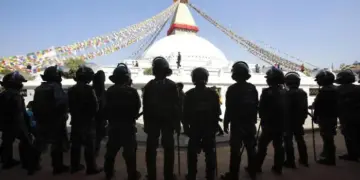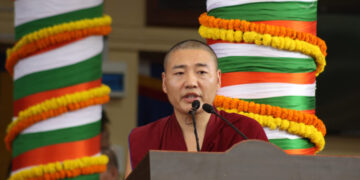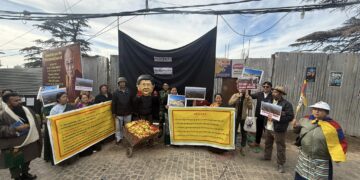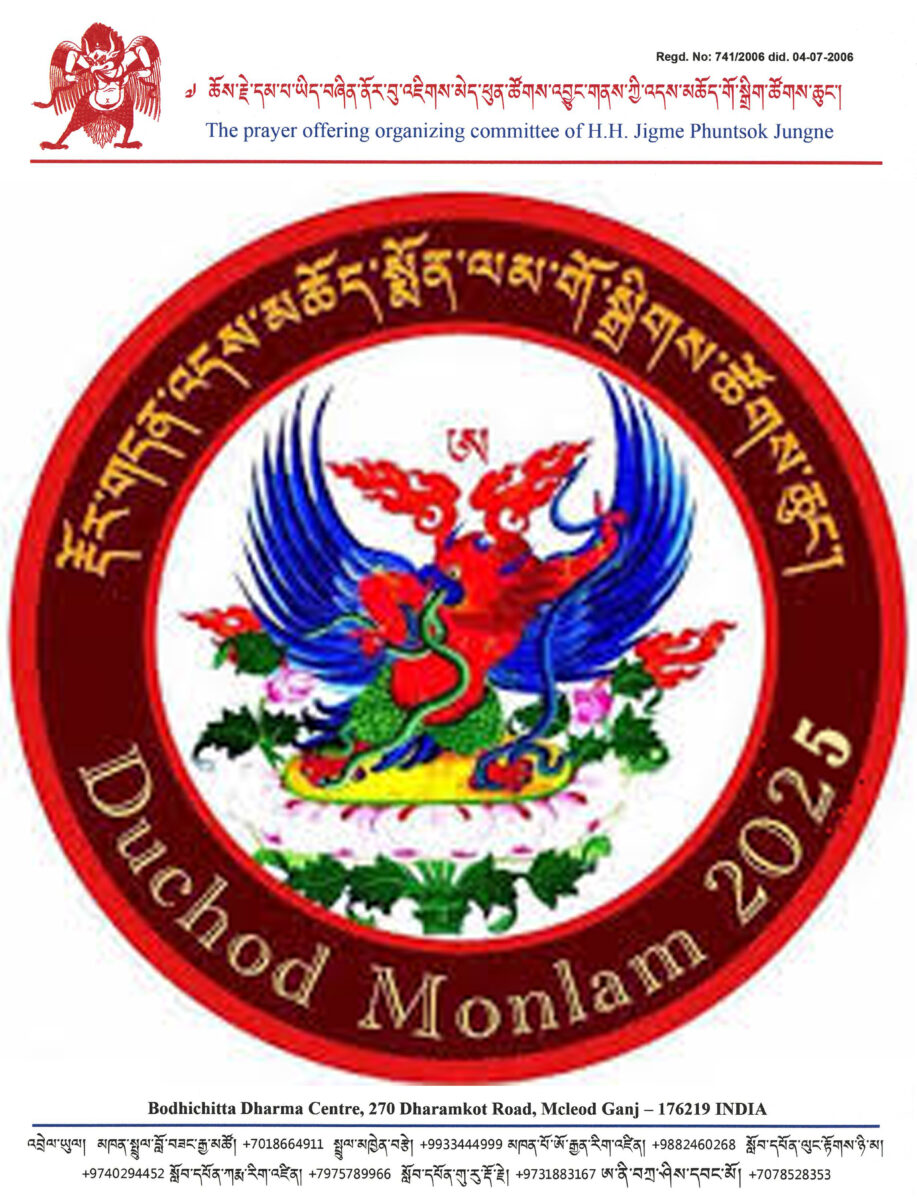ཁ་སང་ཕྱི་ཚེས་ ༡༤ ཉིན་སྤྱི་ནོར་༧གོང་ས་སྐྱབས་མགོན་ཆེན་པོ་མཆོག་གིས་བོད་དོན་དམིགས་བསལ་ཚོགས་ཆེན་ལ་ཆེད་དུ་དམིགས་ཏེ། བོད་ཕྱི་ནང་གཉིས་ཀྱི་བོད་རིགས་ཡོངས་ལ་གལ་ཆེའི་གསུང་འཕྲིན་ཞིག་བསྩལ་ཡོད་པའི་ནང༌། དམིགས་བསལ་ཚོགས་ཆེན་འདི་ནི་གོ་བསྡུར་སྦྱངས་ཤད་ཞིབ་ལྷུག་བྱས་པའི་ལམ་ནས། གཞི་རིམ་མང་ཚོགས་ཀྱི་བསམ་ཚུལ་ངོ་མ་ཅི་ཡིན་ཤེས་རྟོགས་ཡོང་ཐབས་ཁོ་ནའི་ཆེད་དུ་ཡིན་པ་ལས། ཆབ་སྲིད་ཀྱི་ཐབས་བྱུས་སམ་ཁག་དཀྲི་བྱེད་ཡུལ་ལྟ་བུའམ། ཡང་ན། ངེས་ཅན་གྱི་གྲུབ་དོན་གཅིག་གི་ཐོག་འབབ་རེ་བྱེད་པའི་མངོན་པར་མི་གསལ་བའི་དམིགས་ཡུལ་ཡོད་པ་ཞིག་གཏན་ནས་མིན་པ་ངེས་པར་དུ་ཤེས་དགོས། ཞེས་བཀའ་ནན་བསྩལ་ཡོད།
༄༅། ། བོད་ཕྱི་ནང་གཉིས་ཀྱི་བོད་རིགས་ཡོངས་ལ་ཏཱ་ལའི་བླ་མ་སྐྱེ་ཕྲེང་བཅུ་བཞི་པས་འཚམས་འདྲི་དང་བཅས་གལ་ཆེའི་གནས་ཚུལ་འགའ་ཤས་བརྗོད་རྒྱུར། ང་རང་ཆུང་དུས་ནས་བོད་མིའི་འཕྲལ་ཕུགས་ཀྱི་བདེ་དོན་སླད། བོད་ཀྱི་ཆབ་སྲིད་མང་གཙོའི་ལམ་སྲོལ་དུ་བསྒྱུར་རྒྱུ་གལ་ཆེར་མཐོང་སྟེ་ཆོས་སྲིད་ཀྱི་འགན་ཁུར་བླངས་ནས་བཟུང་འབད་བརྩོན་གང་ཡོང་བྱས་པ་ཡིན། འོན་ཀྱང༌། རྒྱ་ནག་མི་དམངས་སྤྱི་མཐུན་རྒྱལ་ཁབ་ཀྱི་བཙན་གནོན་འོག་གྲུབ་འབྲས་ཐོན་ཐུབ་པ་མ་བྱུང༌། བཙན་བྱོལ་དུ་འབྱོར་མ་ཐག་གཞུང་གི་སྒྲིག་འཛུགས་བསྐྱར་བཅོས་དང་འབྲེལ་མང་ཚོགས་ཀྱིས་འོས་འདེམས་བྱས་པའི་སྤྱི་འཐུས་ལྷན་ཚོགས་གསར་འཛུགས་བྱས་པ་ནས་བཟུང༌། བོད་མིའི་མང་གཙོའི་འཕེལ་རིམ་བཙན་བྱོལ་བའི་གནས་བབ་ལ་གཞིགས་པའི་གང་ལེགས་བྱུང་སྟེ། ད་ཆ་དེང་རབས་མང་གཙོའི་མཚན་ཉིད་ཡོངས་སུ་ཚང་བའི་བཅའ་ཁྲིམས་དང་ལྡན་པའི་གཞུང༌། གྲོས་ཚོགས་དང་འཛིན་སྐྱོང་གི་འགོ་ཁྲིད་མང་ཚོགས་ཀྱིས་ཐད་ཀར་འོས་འདེམས་བྱེད་བཞིན་ཡོད། བོད་མི་རིགས་ཀྱི་འགན་ཁུར་བོད་མི་མང་ཚོགས་ཀྱིས་ལེན་ཐུབ་པའི་གནས་བབ་ཅིག་ཆགས་ཡོད་པ་དགའ་སྤོབས་བྱ་འོས་ཀྱི་གནས་སུ་མཆིས།
ངས་མང་གཙོའི་ལམ་སྲོལ་ཚགས་ཚུད་ཡོང་ཐབས་ལ་འབད་བརྩོན་རྒྱུན་སྲིང་བྱས་པའི་དམིགས་ཡུལ་བོད་མིའི་ཆབ་སྲིད་སྲ་བརྟན་རྒྱུན་གནས་ཡོང་ཐབས་ཁོ་ན་ལས་རང་ཉིད་འགན་ཁུར་བྱེད་འདོད་མེད་པའམ་ཡང་ན་གཡོལ་ཐབས་བྱས་པ་ཞིག་གཏན་ནས་མིན། འདས་པའི་བྱུང་རབས་ལས་ཉམས་མྱོང་དང༌། དེང་རབས་རྒྱལ་སྤྱིའི་གནས་བབ་ལས་བསླབ་བྱ་བླངས་ཏེ། བོད་དོན་བདེན་མཐའ་མ་གསལ་བར་བོད་མིའི་འཐབ་རྩོད་རྒྱུན་འཁྱོངས་བྱེད་ཐུབ་པ་དང༌། བོད་ཀྱི་ཆོས་དང་རིག་གཞུང་རྒྱུན་འཛིན་བྱེད་ཐུབ་པ་བཅས་ཀྱི་ཆེད་བཙན་བྱོལ་བོད་མིའི་སྒྲིག་འཛུགས་བཙན་བྱོལ་བོད་མི་མང་ཚོགས་ཀྱིས་སྲ་བརྟན་འཛིན་སྐྱོང་ཐུབ་པ་དགོས་རྒྱུ་ནི་ཧ་ཅང་གལ་གནད་ཆེན་ཡིན། བཙན་བྱོལ་དུ་འབྱོར་ནས་བཟུང༌། མང་གཙོའི་སྙིང་དོན་ལག་བསྟར་གྱིས་བོད་མིའི་ཆབ་སྲིད་ཀྱི་གནད་དོན་གལ་ཆེན་ཁག་གི་ཐད། མང་ཚོགས་ཀྱི་བསམ་འཆར་བསྡུས་ཏེ་ཐག་ཆོད་བྱ་རྒྱུའི་འབད་བརྩོན་རྒྱུན་འཁྱོངས་བྱས་ཡོད། ད་ལྟ་ང་ཚོས་འཛིན་བཞིན་པའི་གཉིས་སྨན་དབུ་མའི་ལམ་གྱི་སྲིད་བྱུས་འདི་ཡང་ལོ་རབས་བདུན་ཅུ་པའི་མགོ་སྟོད་དུ་སྤྱི་འཐུས་ཚོགས་གཙོ་སོགས་མང་ཚོགས་ཀྱི་སྐུ་ཚབ་མཚོན་པའི་མགོ་ཁྲིད་རྣམས་དང་བསམ་ཞིབ་གོ་བསྡུར་ལན་མང་བྱས་ཏེ་གཏན་འབེབས་བྱས་པ་མ་ཟད། སི་ཊས་སི་སྦག་གི་གཏམ་བཤད་ནང་དུའང་མཐའ་མའི་ཐག་གཅོད་བོད་མི་མང་གིས་བྱ་རྒྱུ་ཡིན་པ་གསལ་པོར་བཀོད་ཡོད།
ཕྱི་ལོ་ ༡༩༩༣ ནས་བོད་རྒྱའི་འབྲེལ་ལམ་ཆད་རྗེས་སླར་ཡང་བོད་མིའི་ཆབ་སྲིད་ཀྱི་ལངས་ཕྱོགས་ཇི་དགེའི་སྐོར་གཞིས་བྱེས་མང་ཚོགས་དང་གོ་བསྡུར་གྱིས་ཐག་གཅོད་བྱ་ཆེད། མང་མོས་ཐག་གཅོད་འོས་བསྡུའི་ལས་རིམ་མགོ་འཛུགས་བྱས་པ་ཡིན། འོན་ཀྱང༌། མཐའ་མའི་དངོས་གཞིའི་འོས་བསྡུ་མ་དགོས་པར་སྔོན་འགྲོའི་བསམ་འཆར་མང་ཤོས་གཞིར་བཟུང་སྟེ། སྤྱི་ལྷན་ནས་སྤྱི་མོས་གྲོས་ཆོད་ཀྱི་ལམ་ནས་ངོས་ལ་དུས་བསྟུན་ཐག་གཅོད་བྱ་དགོས་བརྗོད་པ་ལྟར། ད་བར་དབུ་མའི་ལམ་གྱི་སྲིད་བྱུས་རྒྱུན་སྐྱོང་བྱས་པ་དང༌། ཕྱི་ལོ་ ༢༠༠༢ ལོ་ནས་བཟུང་བོད་རྒྱའི་འབྲེལ་ལམ་བསྐྱར་མཐུད་ཀྱིས་འབྲེལ་མོལ་ཐེངས་བརྒྱད་བྱས་ཡོད། དེ་ལ་བརྟེན་ནས་རྒྱལ་སྤྱིའི་ནང་བོད་དོན་ལ་དོ་སྣང་གསར་པ་ཞིག་སླེབས་ཏེ། ཕྱོགས་ཀུན་ནས་ཚད་མཐོའི་རྒྱབ་སྐྱོར་ཐོབ་ཡོད་པ་དང༌། དེ་བཞིན་རྒྱ་རིགས་ཤེས་ཡོན་ཅན་གྱི་རྒྱབ་སྐྱོར་ཡང་ཇེ་མང་དུ་སོང་ཡོད། འོན་ཀྱང༌། བོད་ནང་བཟང་ཕྱོགས་ཀྱི་འགྱུར་བ་གང་ཡང་མ་བྱུང་བ་དང༌། རྒྱ་ནག་མི་དམངས་སྤྱི་མཐུན་རྒྱལ་ཁབ་ཀྱིས་བོད་ལ་འཛིན་པའི་སྲིད་བྱུས་ལ་འགྱུར་བ་གང་ཡང་བྱུང་མེད། འབྲེལ་མོལ་ཐེངས་དྲུག་པའི་རྗེས་སུ་གནས་སྐབས་འབྲེལ་མོལ་མུ་མཐུད་བྱ་འཆར་མེད་རུང༌། འདི་ལོ་བོད་ནང་བྱུང་བའི་ཛ་དྲག་གི་གནས་ཚུལ་ལ་བརྟེན་ཏེ། ཕྱི་ཟླ་ ༥ པའི་ཚེས་ཤར་ལ་ནང་མོལ་གྱི་གོ་བསྡུར་ཞིག་དང༌། ཕྱི་ཟླ་བདུན་པའི་ཟླ་འགོར་འབྲེལ་མོལ་ཐེངས་བདུན་པ། ཟླ་འདིའི་ནང་འབྲེལ་མོལ་ཐེངས་བརྒྱད་པ་བཅས་མ་ལན་མ་འགྱོད་པའི་ཚུལ་དུ་བྱས་ཀྱང་དོན་དམ་གྱི་གྲུབ་འབྲས་གང་ཡང་མ་བྱུང༌།
འདི་ལོ་ཕྱི་ཟླ་ ༣ ནས་བཟུང་བོད་ནང་རྒན་གཞོན་དང་ཕོ་མོ། སེར་སྐྱ། ཆོས་དད་ཡོད་མེད་སོགས་ཀྱི་དབྱེ་བ་མེད་པར་སློབ་ཕྲུག་ཡན་གྱི་ཆོལ་གསུམ་བོད་རིགས་རྣམས་ཀྱིས་རང་གི་སེམས་ནང་འདོད་པ་མ་ཁེངས་པའི་སེམས་ནད་གཏིང་ཟབ་ཡོད་པ། ལུས་སྲོག་བློས་བཏང་གིས་སྙིང་སྟོབས་ཆེན་པོས་ཁྲིམས་མཐུན་ཞི་བའི་ལམ་ནས་གསལ་པོ་ཕྱིར་བཏོན་བྱས་ཡོད། སྐབས་དེར་ང་རང་གིས་རྒྱ་ནག་གཞུང་གིས་དངོས་ཡོད་གནས་ཚུལ་ལ་གཞིགས་པའི་ཐབས་ལམ་ཞིག་ལག་ལེན་བསྟར་རྒྱུའི་རེ་བ་ཆེན་པོ་བྱས་པ་ཡིན། འོན་ཀྱང༌། དེ་ལས་ལྡོག་སྟེ་བོད་མིའི་སེམས་ཀྱི་རེ་འདུན་ནག་བསུབ་བཏང་ནས་ཁ་བྲལ་བ་དང༌། ལོག་སྤྱོད་པ་ཟེར་བའི་ཉེས་མིང་བཀལ་ནས་དྲག་གནོན་ཚད་མེད་བཏང་སོང༌། སྐབས་དེར་བདག་གིས་འགན་བཟོད་མིན་གྱིས་སྲིད་འཛིན་ཧུ་ཅིན་ཐའོ་ལ་འཕྲིན་ཡིག་ཕུལ་བ་སོགས་རྒྱལ་སྤྱི་དང་རྒྱལ་ནང་བཅས་ཕྱོགས་གང་སར་ཐབས་ཤེས་ཡོད་རྒུ་རྩལ་སྤྲུགས་བྱས་ཀྱང་དོན་འབྲས་ཆེ་བ་མ་བྱུང༌། སྐབས་དེར་ཨོ་ལམ་པིག་རྩེད་འགྲན་པེ་ཅིང་དུ་འཚོགས་རྒྱུའི་སྦིར་ཟིང་ཡོད་མུས་ལ་བརྟེན། བོད་མི་མང་ཚོགས་ལ་གོ་བསྡུར་བྱ་རྒྱར་སྟབས་བདེ་མ་བྱུང༌། འོན་ཀྱང༌། ད་ཆར་གྲོས་བསྡུར་གྱི་དུས་ཚོད་འོས་འཚམས་འདུག་སྟབས། བཅའ་ཁྲིམས་དོན་ཚན་ང་དགུ་པའི་ཆ་རྐྱེན་འོག་དམིགས་བསལ་ཚོགས་ཆེན་ཞིག་བསྡུ་བསྐོང་དགོས་པ། བཀའ་སྤྱི་ཐུན་མོང་ལ་འདི་ལོ་ཕྱི་ཟླ་ ༩ ཚེས་ ༡༡ ཉིན་ལམ་སྟོན་བྱས་པ་ལྟར། ད་ཆ་ཚོགས་ཆེན་ཚོགས་ཉེར་ཡོད་པ་འདིའི་ཐོག་ཚོགས་མི་ཡོངས་ཀྱིས་རང་རང་ཁྱབ་ཁོངས་མང་ཚོགས་ཀྱི་བསམ་འཆར་ཅི་ཡོད་གསལ་འདོན་བྱེད་པའི་རེ་བ་ཡོད།
ཚོགས་ཆེན་སྟེང༌། འདི་ལོ་བོད་ནང་བྱུང་བའི་རླབས་ཆེན་གྱི་ལས་འགུལ་ཁག་དང༌། དེ་འབྲེལ་རྒྱལ་སྤྱིའི་གནས་བབ། ད་ལྟའི་རྒྱ་ནག་གཞུང་གི་བྱེད་ཕྱོགས་བཅས་དངོས་ཡོད་གནས་ཚུལ་རྣམས་གཞི་རྩར་བཞག་སྟེ་འབྱུང་འགྱུར་བོད་མིའི་རྩ་དོན་སྒྲུབ་ཕྱོགས་ཁྱོན་ཡོངས་ཀྱི་གནས་ཚུལ་ཐོག་འཕྲལ་ཕུགས་རྒྱང་གསུམ་གྱི་བསམ་བློ་བཏང་སྟེ། ཚོགས་མི་ཚང་མས་བོད་ཀྱི་ཡུལ་མིའམ་སྤྱི་འབངས་གཅིག་གྱུར་ཡིན་པའི་གནས་བབ་ཀྱིས་འདྲ་མཉམ་དང༌། ཕྱར་གྲུ་མཉམ་འདེགས། ཁུར་མཉམ་ལེན་ཐོག་ནས་གང་དགའ་ཅི་ལེགས་ཀྱི་གོ་བསྡུར་ལྷུག་པོ་བྱེད་དགོས། དེ་ཡང་དེང་རབས་སྲིད་དོན་ཚོགས་པ་ཁག་གིས་ཆབ་སྲིད་ལྟ་གྲུབ་མཁྲེགས་འཛིན་གྱིས་རྩོད་གླེང་བྱེད་པ་ལྟ་བུུ་མ་ཡིན་པར་མང་ཚོགས་ཀྱི་བསམ་འཆར་ངོ་མ་ལྷད་མེད་ཚོགས་ཆེན་གྱི་སྡིངས་ཆའི་ཐོག་གསལ་འདོན་བྱེད་དགོས། དེའི་ཐད་ཚང་མས་འབད་བརྩོན་བྱ་རྒྱུར་ངས་རེ་སྐུལ་ནན་པོ་བྱེད་ཀྱིན་ཡོད།
དམིགས་བསལ་ཚོགས་ཆེན་འདི་ནི་གོ་བསྡུར་སྦྱངས་ཤད་ཞིབ་ལྷུག་བྱས་པའི་ལམ་ནས་གཞི་རིམ་མང་ཚོགས་ཀྱི་བསམ་ཚུལ་ངོ་མ་ཅི་ཡིན་ཤེས་རྟོགས་ཡོང་ཐབས་ཁོ་ནའི་ཆེད་དུ་ཡིན་པ་ལས། ཆབ་སྲིད་ཀྱི་ཐབས་བྱུས་སམ་ཁག་དཀྲི་བྱེད་ཡུལ་ལྟ་བུའམ། ཡང་ན་ངེས་ཅན་གྱི་གྲུབ་དོན་གཅིག་གི་ཐོག་འབབ་རེ་བྱེད་པའི་མངོན་པར་མི་གསལ་བའི་དམིགས་ཡུལ་ཡོད་པ་ཞིག་གཏན་ནས་མིན་པ་འདི་ངེས་པར་ཤེས་པ་བྱེད་དགོས།
ཏཱ་ལའི་བླ་མས་ ༢༠༠༨ ཕྱི་ཟླ་ ༡༡ ཚེས་ ༡༤ ལ།།










དགྲ་འདུལ་ལགས་ཁྱོད་རང་གིས་ཤེས་མི་འདུག “མངོན་པར་མི་གསལ་བ་” ཞེས་པའི་ཚིག་འདི་སུའི་ཡིན་མིན་དཔྱད་དགོས། ངས་ལྟས་ན་ཕལ་ཆེར་༸གོང་ས་མཆོག་གི་ཡིན་ས་མ་རེད། དཀོན་མཆོག་གསུམ། ཁྱོད་ཀྱིས་ཡག་པོ་ཞིག་ལྟོས་དང། ཐུགས་རྗེ་ཆེ།
༧གོང་ས་མཆོག་གི་གསུང་འཕྲིན་འདིའི་མཇུག་སྡོམ་དེ་ལོ་འདིའི་ཕྱི་ཟླ་ ༩ པའི་ཚེས་ ༡༡ ཉིན་གྱི་གསུང་འཕྲིན་ནང་བཀོད་དང་མ་བཀོད་ལ་ཁྱད་པར་གང་འདྲ་ཞིག་མཐོང་གི་འདུག
༧རྒྱལ་བ་རིན་པོ་ཆེ་མཆོག་གིས་གཞི་རིམ་མང་ཚོགས་ཀྱི་བསམ་ཚུལ་ངོ་མ་ད་བར་མ་མཁྱེན་པ་ཡིན་ནམ།
གལ་སྲིད་མཁྱེན་མེད་པ་ཡིན་ན་ཐེངས་འདིའི་དམིགས་བསལ་ཚོགས་ཆེན་གྱི་སྟེང་ནས་གཞི་རིམ་མང་ཚོགས་ཀྱི་བསམ་ཚུལ་ངོ་མ་དེ་མཁྱེན་ཐུབ་གི་རེད་དམ།
མངོན་པར་མི་གསལ་བའི་དམིགས་ཡུལ་ཞིག་གཏན་ནས་མེད་ཅེས་པ་འདི་བོད་རིགས་ཡོངས་ལ་དོགས་སེལ་གནང་བ་རེད་དམ། ཡང་ན། བཤད་ས་བུ་མོ་དང་ཉན་ས་མནའ་མ་ཞེས་པའི་དཔེ་ལྟརརྒྱལ་ཁབ་དང་མི་རིགས་གཞན་ཞིག་ལ་དམིགས་ནས་གསུངས་པ་རེད།
གཤམ་གྱི་གསལ་བསྒྲགས་འདི་བོད་ཡིག་ནང་དུས་ལྟར་ཐོན་མི་ཐུབ་པའི་རྒྱུ་མཚན་ཅི། གལ་སྲིད་གསལ་བསྒྲགས་ཙམ་ཡང་བོད་ཡིག་ནང་དུས་ལྟར་ཐོན་ཐུབ་ཀྱི་མེད་ན། ༼རིག་གཞུང་སྲུང་སྐྱོབ༽ཅེས་པའི་མིང་རྫིག་པོ་དེ་རྒྱན་ཆ་རེད་དམ་ཁ་གཡར་ས་ཙམ་རེད།
SUMMARY OF THE MEMORANDUM ON GENUINE AUTONOMY FOR THE TIBETAN PEOPLE
INTRODUCTION
During the seventh round of talks in Beijing on 1 and 2 July 2008, the Vice Chairman of the Chinese People’s Political Consultative Conference and the Minister of the Central United Front Work Department, Mr. Du Qinglin, explicitly invited suggestions from His Holiness the Dalai Lama for the stability and development of Tibet. The Executive Vice Minister of the Central United Front Work Department, Mr. Zhu Weiqun, further said they would like to hear our views on the degree or form of autonomy we are seeking as well as on all aspects of regional autonomy within the scope of the Constitution of the People’s Republic of China (PRC).
Accordingly, during the recent eighth round of talks we presented the Memorandum on Genuine Autonomy for the Tibetan People to the vice Chairman, Mr. Du Qinglin and held extensive discussions with our Chinese counterparts on November 4th and 5th in Beijing.
In recent days the Central United Front Work Department of the Chinese Communist Party has issued statements about our talks in Beijing and in particular about the content of the memorandum we have presented to them. These Chinese statements distort the position and proposal we have outlined in our paper. In order to enable the public, concerned governments, parliamentarians, non-governmental organisations and individuals to gain a comprehensive and full understanding of the Tibetan position on genuine autonomy for the Tibetan people, we are releasing today the memorandum.
Our memorandum puts forth our position on genuine autonomy and how the specific needs of the Tibetan nationality for autonomy and self-government can be met through application of the principles on autonomy of the Constitution of the People’s Republic of China, as we understand them. On this basis, His Holiness the Dalai Lama felt confident that the basic needs of the Tibetan nationality can be met through genuine autonomy within the PRC.
SUMMARY OF THE MEMORANDUM
The Constitution of the PRC contains fundamental principles on autonomy and self-government whose objectives are compatible with the needs and aspirations of the Tibetans. Regional national autonomy is aimed at opposing both the oppression and the separation of nationalities by rejecting both Han chauvinism and local nationalism. It is intended to ensure the protection of the culture and the identity of minority nationalities by empowering them to become masters of their own affairs.
To a very considerable extent Tibetan needs can be met within the constitutional principles on autonomy. On several points, the Constitution gives significant discretionary powers to state organs in decision-making and on the operation of the system of autonomy. These discretionary powers can be exercised to facilitate genuine autonomy for Tibetans in ways that would respond to the uniqueness of the Tibetan situation. Given good will on both sides, outstanding problems can be resolved within the constitutional principles on autonomy. In this way national unity and stability and harmonious relations between the Tibetan and other nationalities will be established.
TIBETAN ASPIRATIONS
Tibetans have a rich and distinct history, culture and spiritual tradition all of which form valuable parts of the heritage of humanity. Not only do Tibetans wish to preserve their own heritage, which they cherish, but equally they wish to further develop their culture and spiritual life and knowledge in ways that are particularly suited to the needs and conditions of humanity in the 21st century.
As a part of the multi-national state of the PRC, Tibetans can benefit greatly from the rapid economic and scientific development the country is experiencing. While wanting to actively participate and contribute to this development, we want to ensure that this happens without the people losing their Tibetan identity, culture and core values and without putting the distinct and fragile environment of the Tibetan plateau, to which Tibetans are indigenous, at risk.
His Holiness the Dalai Lama’s commitment to seek a solution for the Tibetan people within the PRC is clear and unambiguous. This position is in full compliance and agreement with paramount leader Deng Xiaoping’s statement in which he emphasised that except for independence all other issues could be resolved through dialogue. Whereas, we are committed, therefore, to fully respect the territorial integrity of the PRC, we expect the Central Government to recognise and fully respect the integrity of the Tibetan nationality and its right to exercise genuine autonomy within the PRC. We believe that this is the basis for resolving the differences between us and promoting unity, stability and harmony among nationalities.
BASIC NEEDS OF TIBETANS
Subject Matters of Self-government
1) Language
2) Culture
3) Religion
4) Education
5) Environmental Protection
6) Utilisation of Natural Resources
7) Economic Development and Trade
8) Public health
9) Public Security
10) Regulation on population migration
11) Cultural, educational and religious exchanges with other countries
RESPECT FOR THE INTEGRITY OF THE TIBETAN NATIONALITY
Tibetans belong to one minority nationality regardless of the current administrative divisions. The integrity of the Tibetan nationality must be respected. That is the spirit, the intent and the principle underlying the constitutional concept of national regional autonomy as well as the principle of equality of nationalities.
There is no dispute about the fact that Tibetans share the same language, culture, spiritual tradition, core values and customs, that they belong to the same ethnic group and that they have a strong sense of common identity. Tibetans share a common history and despite periods of political or administrative divisions, Tibetans continuously remained united by their religion, culture, education, language, way of life and by their unique high plateau environment.
The Tibetan nationality lives in one contiguous area on the Tibetan plateau, which they have inhabited for millennia and to which they are therefore indigenous. For purposes of the constitutional principles of national regional autonomy Tibetans in the PRC in fact live as a single nationality all over the Tibetan plateau.
In order for the Tibetan nationality to develop and flourish with its distinct identity, culture and spiritual tradition through the exercise of self-government on the above mentioned basic Tibetan needs, the entire community, comprising all the areas currently designated by the PRC as Tibetan autonomous areas, should be under one single administrative entity. The current administrative divisions, by which Tibetan communities are ruled and administered under different provinces and regions of the PRC, foments fragmentation, promotes unequal development, and weakens the ability of the Tibetan nationality to protect and promote its common cultural, spiritual and ethnic identity. Rather than respecting the integrity of the nationality, this policy promotes its fragmentation and disregards the spirit of autonomy.
THE NATURE AND STRUCTURE OF THE AUTONOMY
The exercise of genuine autonomy would include the right of Tibetans to create their own regional government and government institutions and processes that are best suited to their needs and characteristics. It would require that the People’s Congress of the autonomous region have the power to legislate on all matters within the competencies of the region and that other organs of the autonomous government have the power to execute and administer decisions autonomously. Autonomy also entails representation and meaningful participation in national decision-making in the Central Government. Processes for effective consultation and close cooperation or joint decision-making between the Central Government and the regional government on areas of common interest also need to be in place for the autonomy to be effective.
A crucial element of genuine autonomy is the guarantee the Constitution or other laws provide that powers and responsibilities allocated to the autonomous region cannot be unilaterally abrogated or changed. This means that neither the Central Government nor the autonomous region’s government should be able, without the consent of the other, to change the basic features of the autonomy.
Implementation of genuine autonomy, for example, requires clear divisions of powers and responsibilities between the Central Government and the government of the autonomous region with respect to subject matter competency. Currently there is no such clarity and the scope of legislative powers of autonomous regions is both uncertain and severely restricted. Thus, whereas the Constitution intends to recognise the special need for autonomous regions to legislate on many matters that affect them, the requirements of Article 116 for prior approval at the highest level of the Central Government – by the Standing Committee of National People’s Congress (NPC) – inhibit the implementation of this principle of autonomy. In reality, it is only autonomous regional congresses that expressly require such approval, while the congresses of ordinary (not autonomous) provinces of the PRC do not need prior permission and merely report the passage of regulations to the Standing Committee of the NPC “for the record” (Article 100).
The exercise of autonomy is further subject to a considerable number of laws and regulations, according to Article 115 of the Constitution. Certain laws effectively restrict the autonomy of the autonomous region, while others are not always consistent with one another. The result is that the exact scope of the autonomy is unclear and is not fixed, since it is unilaterally changed with the enactment of laws and regulations at higher levels of the state, and even by changes in policy. There is also no adequate process for consultation or for settling differences that arise between the organs of the Central Government and of the regional government with respect to the scope and exercise of autonomy. In practice, the resulting uncertainty limits the initiative of regional authorities and impedes the exercise of genuine autonomy by Tibetans today.
Dharamsala, 16 Nov. 2008
དྲ་གྲོགས་གནས་ཚང་ལགས། ཁྱེད་རང་གི་ཚོད་དཔག་བྱེད་པ་ལས་དེ་རེད་ཅེས་བཤད་ཡོད་ན། ངས་ཀྱང་རྒྱབ་སྐྱོར་ལོས་བྱེད། འོན་ཀྱང་ཁྱེད་ཀྱིས་དེ་འདྲ་ཞིག་མིན་འགྲོ་ཟེར་ནས་འགྲོ་སྲོལ་བལྟས་ན་ཁྱེད་རང་ལ་ཡང་ཨ་ཞང་ཚང་གི་གནོན་ཤུགས་སྤྲད་མི་ཡོང་བར་སྐྲག་ནས་འདུག་མཁན་ཞིག་ཡིན་པ་འདུག སྐྲག་དགོས་ནི་མ་རེད་ཨ་ཞང་ཚང་གི་ངེད་ཅག་ཕྱི་བསྡོད་པ་ཚོ་ལ་སྐྲན་ནས་བསྡད་ཡོད་པ་མ་གཏོགས་ཅི་ཡང་བྱེད་ཐུབ་ནི་མ་རེད། ཨ་ལ་ཀུ་རེ་ཡིན། འོན་ཀྱང་ང་ཚོས་རང་གི་དབུ་ཁྲིད་དཀའ་ངལ་ལ་ཐུགས་ཡོད་པ་ཤེས་བཞིན་དུ་དེའི་སྒང་ལ་དཀའ་ངལ་མི་སྤྲོད་རྒྱུ་དེ་ང་རང་བོད་པ་ཚང་གི་ལས་འགན་ཆགས་ཡོད། དེ་ཤེས་པར་གྱིས་ཤིག་ལགས། དྲ་གྲོགས་རིག་བཟང་གི་བུ། བོད་ཀྱི་བུ།
ངས་བལྟས་ན་རྒྱ་གར་གྱི་གནོན་ཤུགས་མ་རེད། དེ་ནི་རྒྱ་ནག་གི་གནོན་ཤུགས་རེད་ལ། 《ཡང་ན་ངེས་ཅན་གྱི་གྲུབ་དོན་གཅིག་གི་ཐོག་འབབ་རེ་བྱེད་པའི་མངོན་པར་མི་གསལ་བའི་དམིགས་ཡུལ་ཡོད་པ་ཞིག་གཏན་ནས་མིན་པ》ཞེས་པ་འདི་དང་། རྒྱ་ནག་གཞུང་འབྲེལ་མཁས་པ་ཞིག་གིས་༼དབུ་མའི་ལམ་ནི་གྲུབ་ཆ་གསུམ་ལྡན་ཅན་ཞིག་སྟེ། ༡ འབྲེལ་མོལ། ༢ འཚེ་མེད་ཞི་བ། ༣ རང་སྐྱོང་ཆེན་པོ། དེ་བས། ཐེངས་འདིའི་ཚོགས་འདུའི་སྒང་ལམ་ཁ་དེ་གཡུགས་སྲིད་ཀྱི་མ་རེད་ལ། དེ་ནི་ཏཱ་ལའི་བླ་མས་ཐབས་ལམ་འདི་སྤྱད་ནས་དབུས་གཞུང་ལ་གནོན་ཤུགས་སྤྲོད་འདུན་དང་། བོད་མི་ནང་ཁུལ་གྱི་གནོན་ཤུགས་ཞི་འཇམ་དུ་གཏོང་ཐབས་ཁོ་ན་ཙམ་རེད་༽ཞེས་པ་འདིའི་ལན་འདྲ་བོ་མིན་འགྲོ་བསམ།
རེད། ངས་བསམ་ན་དེ་ནི་རྒྱ་ནག་གི་གཡོ་འཕྲུལ་ཞིག་སྟེ། ང་ཚོས་ཆབ་སྲིད་ཀྱི་ལང་ཕྱོགས་དང་མང་གཙོའི་ལྟ་བ་ནི་དེ་འདྲ་བསྟན་པོ་ཞིག་མེད་པར་མཐོང་ནས་གླེགས་འཚོལ་གྱིན་ཡོད་པ་རེད།
དེའི་ཕྱིར་ང་ཚོས་ངོས་ནས་ཀྱང་དེར་གྲ་སྒྲིག་ནན་མོ་ཞིག་བྱེད་དགོས་ལས་གང་ཡིན་འདི་ཡིན་དོགས་ཟོན་མང་པོ་ཞིག་གི་ནང་འཁོར་སྡོད་དུས་མིན་པར་སྣང་། རང་རང་གི་བསམ་བློའི་ནང་གི་ཆབ་སྲིད་ལྟ་བའི་ཁ་ཕྱོགས་དང་བསམ་བློ་གསར་ཁུར་ཡོང་རྒྱུ་གལ་ཆེན་རེད།
མི་ནག་ཚང་ལུང་རིགས་རྒྱལ་གྱིས་བཤད་པར་རྒྱུ་མཚན་ཆེན་པོ་འདུག དེ་སྔ་ཡིན་ན་༸གོང་ས་མཆོག་གིས་ཆབ་སྲིད་ཀྱི་འགན་དབང་བཞེས་རྒྱུ་ཡིན་མིན་དང་། བོད་རྒྱ་གྲོས་མོལ་གྱི་འགན་བཞེས་རྒྱུ་ཡིན་མིན་སོགས་ཅུང་ཙམ་གསུང་བཤད་བཙན་ལྗིད་ཅན་ཕབ་ཡོད། འོན་ཀྱང་ཐེངས་འདིར་《དམིགས་བསལ་ཚོགས་ཆེན་འདི་ནི་གོ་བསྡུར་སྦྱངས་ཤད་ཞིབ་ལྷུག་བྱས་པའི་ལམ་ནས་གཞི་རིམ་མང་ཚོགས་ཀྱི་བསམ་ཚུལ་ངོ་མ་ཅི་ཡིན་ཤེས་རྟོགས་ཡོང་ཐབས་ཁོ་ནའི་ཆེད་དུ་ཡིན་པ་ལས། ཆབ་སྲིད་ཀྱི་ཐབས་བྱུས་སམ་ཁག་དཀྲི་བྱེད་ཡུལ་ལྟ་བུའམ། ཡང་ན་ངེས་ཅན་གྱི་གྲུབ་དོན་གཅིག་གི་ཐོག་འབབ་རེ་བྱེད་པའི་མངོན་པར་མི་གསལ་བའི་དམིགས་ཡུལ་ཡོད་པ་ཞིག་གཏན་ནས་མིན་པ་འདི་ངེས་པར་ཤེས་པ་བྱེད་དགོས།》ཞེས་གསུངས་དགོས་ཐུག་འདུག་ འདི་ནི་ཆོ་འཕྲུལ་ཆེན་པོ་ཞིག་ཡིན་ལ། ཆོ་འཕྲུལ་འདི་འདྲ་བཤིག་མཁན་ནི་རྒྱ་ནག་གམ་ཡང་ན་རྒྱ་གར་ཡིན་སྲིད། དོན་དངོས་ཐོག་གནས་སྟངས་འདིས་ཅི་མཚོན་ཞེ་ན། ༸གོང་ས་མཆོག་གིས་སྙོར་སྙོར་ནས་འཚར་ལོངས་བྱུང་བའི་བོད་ཕྲུག་ཚོས་འཇོན་གྱི་མེད་པ་དང་། བོད་ཕྲུག་ཚོར་བརྟན་ཚུགས་ཀྱི་ཆབ་སྲིད་བསམ་བློ་མེད་པའི་མཚོན་རྟགས་ཤིག་རེད། གལ་སྲིད་ཐེངས་འདིའི་ཚོགས་འདུ་དེ《ཡང་ན་ངེས་ཅན་གྱི་གྲུབ་དོན་གཅིག་གི་ཐོག་འབབ་རེ་བྱེད་པའི་མངོན་པར་མི་གསལ་བའི་དམིགས་ཡུལ་ཡོད་པ་ཞིག་གཏན་ནས་མིན་པ》ཡིན་ན་ཚོགས་འདུ་ཅིའི་ཕྱིར་འཚོགས་དགོས་བྱུང་བ་རེད། སོམ་དང་། ངས་བསམ་ན་ཆོ་འཕྲུལ་འདི་ནི་བོད་གཞུང་དང་རྒྱ་ནག་གཉིས་ཀྱི་ཆོ་འཕྲུལ་ཞིག་ལ་མཐོང་གི་འདུག
དྲ་གནས་འདིས་གནས་བདག་ལགས། ཁྱེད་ཀྱིས་རྒྱ་གར་གཞུང་གིས་ཁོང་ལ་ཞལ་པར་འདྲ་ཕུལ་ཡོད་སྲིད་ཟེར་ནས་དོགས་པ་ཞིག་འཁུར་ཡོང་དོན་ཅི་ཡིན། དེའི་ཐད་དུ་སྐུ་ཉིད་ཀྱིས་བསམ་ཚུལ་ལྷུག་པོར་གནང་ན་འགྲིག་གི་རེད་དམ། ད་དུང་འདིའི་ཐད་ཉན་ཐུབ་མཁན་རེ་དང་དགོངས་ཚུལ་གསུང་ཐུབ་མཁན་རེ་ཡོད་འདིར་འགོད་རོགས་ཟེར་ནས་བློ་འཚབ་ཧ་ཅང་ཆེ་བའི་གནད་དོན་ཞིག་དུས་བབ་ཚང་གི་དྲ་གྲོགས་ཚོ་དཀྱིལ་དང་བོད་ཀྱི་དུས་བབ་དྲ་ཚིགས་འདི་ཀློག་པ་པོ་ཡོངས་ཀྱི་མིག་མདུན་ལ་སྐད་ཆ་འདི་འདྲ་བཤད་དོན་གང་ཡིན་ཟེར་ནས་ངས་ཁྱེད་རང་ལ་དྲི་བ་ཞིག་དྲིས་ན་ལན་ཞིག་གནང་རོགས་ཞུ།
ཐེངས་འདིར་༧གོང་ས་མཆོག་ལ་གནོན་ཤུགས་ཆེན་པོ་ཞིག་སྤྲད་འདུག་པ་གསལ་བོ་རེད། ལྷག་པར་དུ་ཁོང་གི་གསུང་སྒྲོས་མཐའ་མའམ། གསུང་འཕྲིན་གྱི་མཇུག་སྡོམ་ནང་དུ་དམིགས་བསལ་ཚོགས་ཆེན་འདིའི་ཐད་ཁོང་ལ་མངོན་གསལ་གྱི་གནོན་ཤུགས་ཤིག་སྤྲད་པ་མཐོང་ཐུབ་གི་འདུག རྒྱ་གར་གཞུང་གིས་ཁོང་ལ་ཞལ་པར་འདྲ་ཕུལ་ཡོད་སྲིད། འདིའི་ཐད་ཉན་ཐུབ་མཁན་རེ་དང་དགོངས་ཚུལ་གསུང་ཐུབ་མཁན་རེ་ཡོད་ན་འདིར་འགོད་རོགས།
ད་ཡག་པོ་འདུག དོན་ངོ་མ་མང་ཚོགས་ཀྱི་བསམ་ཚུལ་བསྡུ་ལེན་བྱེད་ཀྱི་ཡོད་ན། པཱ་ལེ་བས་སོ་སོའི་འདོད་ཚུལ་བསྐྱར་བཤད་བྱེད་ཀྱི་ཡིན།
ཏཱ་ལའི་བླ་མས་དབུ་མའི་ལམ་གྱི་མཐའ་ཐུག་གི་ཐག་གཅོད་མི་མང་ལ་ཡོད་ཅེས་པ་ནི་༼རང་ཐག་རང་གཅོད་༽ཆགས་ཀྱི་ཡོད་དམ། རང་ཐག་རང་གཅོད་ལ་དགེ་མཚན་གསུམ་ཡོད།
༼༡༽པེ་ཅིང་གིས་རང་ཐག་རང་གཅོད་ངོས་ལེན་ཡོད་པའི་རྒྱལ་སྤྱིའི་ཡིག་ཆ་གཉིས་མིང་རྟགས་བཀོད་ཡོད་པས། འདི་བོད་མིས་ཁྲིམས་ལུགས་ཀྱི་རྒྱབ་བརྟེན་དུ་བཟུང་ཆོག་པར་མ་ཟད། པེ་ཅིང་གིས་ཀྱང་དེར་ཞཱ་མོ་གང་བྱུང་འདི་བྱུང་དུ་གཡོགས་ཐུབ་ཀྱི་མེད།
༼༢༽ པེ་ཅིང་གིས་རང་ཐག་རང་གཅོད་ངོས་ལེན་ཡོད་པའི་རྒྱལ་སྤྱིའི་ཡིག་ཆ་གཉིས་མིང་རྟགས་བཀོད་ཡོད་པའི་ཆ་ནས་རྒྱལ་སྤྱིའི་སྤྱི་ཚོགས་ལ་པེ་ཅིང་གིས་ཁྲིམས་སྲོལ་དེ་རིགས་ལག་ལེན་དོན་འཁྱོལ་ཡོང་བར་བསྐུལ་འདེད་བྱེད་པའི་འོས་འགན་ཡོད་ལ། ཁ་གཡར་སའང་གཙོ་བོ་ཞིག་ཆགས་ཡོད།
༼༣༽ ལམ་ཁ་འདི་གདམ་པ་ཡིན་ན། ད་ལྟའི་བོད་མིས་མ་འོངས་པའི་མི་རབས་ཀྱི་ལམ་ཁ་འགག་ཏུ་བཅུག་མེད། དེ་ལས་ལྡོག་ན། མ་འོངས་མི་རབས་ལ་ནུས་པ་ཡོད་ཀྱང་གཞི་འཛིན་ས་འཆོལ་ཟིན་པའི་དཀའ་ངལ་ཡོང་གི་ཡོད།
ད་ཤོད་ཡཱ་སྨྱུག་འཛིན་པ་ཚོ། པཱ་ལེ་བ་ལ་གནང་དོགས་མེད།
ང་ནི་དུས་བབ་དྲ་ཚུགས་ཚང་གི་སྐུ་མགྲོན་གསར་བ་ཡིན། དྲ་གྲོགས་ཚང་མས་གོང་གི་༧གོང་ས་མཆོག་གི་གསུང་འཕྲིན་དེར་དབྱེ་ཞིབ་དང་། བསམ་གཞིགས་ནན་གྱིས་བྱས་ཏེ། བསམ་ཚུལ་རེ་བརྗོད་རྒྱུ་ཧ་ཅང་གནད་འགག་རེད་སྙམ།
གཟིགས་དང་། གསོན་དང་། སོམས་དང་། ༧གོང་ས་མཆོག་གིས་འདི་ལྟར་གསུངས་འདུག འདི་ལོ་བོད་ནང་བྱུང་བའི་རླབས་ཆེན་གྱི་ལས་འགུལ་ཁག་དང༌། དེ་འབྲེལ་རྒྱལ་སྤྱིའི་གནས་བབ། ད་ལྟའི་རྒྱ་ནག་གཞུང་གི་བྱེད་ཕྱོགས་བཅས་དངོས་ཡོད་གནས་ཚུལ་རྣམས་གཞི་རྩར་བཞག་སྟེ་འབྱུང་འགྱུར་བོད་མིའི་རྩ་དོན་སྒྲུབ་ཕྱོགས་ཁྱོན་ཡོངས་ཀྱི་གནས་ཚུལ་ཐོག་འཕྲལ་ཕུགས་རྒྱང་གསུམ་གྱི་བསམ་བློ་བཏང་སྟེ། ཚོགས་མི་ཚང་མས་བོད་ཀྱི་ཡུལ་མིའམ་སྤྱི་འབངས་གཅིག་གྱུར་ཡིན་པའི་གནས་བབ་ཀྱིས་འདྲ་མཉམ་དང༌། ཕྱར་གྲུ་མཉམ་འདེགས། ཁུར་མཉམ་ལེན་ཐོག་ནས་གང་དགའ་ཅི་ལེགས་ཀྱི་གོ་བསྡུར་ལྷུག་པོ་བྱེད་དགོས། ཞེས་གསུངས་འདུག་ལ།
ད་དུང་། ཁོང་གིས་འདི་ལྟར་གསུངས་འདུག དམིགས་བསལ་ཚོགས་ཆེན་འདི་ནི་གོ་བསྡུར་སྦྱངས་ཤད་ཞིབ་ལྷུག་བྱས་པའི་ལམ་ནས་གཞི་རིམ་མང་ཚོགས་ཀྱི་བསམ་ཚུལ་ངོ་མ་ཅི་ཡིན་ཤེས་རྟོགས་ཡོང་ཐབས་ཁོ་ནའི་ཆེད་དུ་ཡིན་པ་ལས། ཆབ་སྲིད་ཀྱི་ཐབས་བྱུས་སམ་ཁག་དཀྲི་བྱེད་ཡུལ་ལྟ་བུའམ། ཡང་ན་ངེས་ཅན་གྱི་གྲུབ་དོན་གཅིག་གི་ཐོག་འབབ་རེ་བྱེད་པའི་མངོན་པར་མི་གསལ་བའི་དམིགས་ཡུལ་ཡོད་པ་ཞིག་གཏན་ནས་མིན་པ་འདི་ངེས་པར་ཤེས་པ་བྱེད་དགོས།